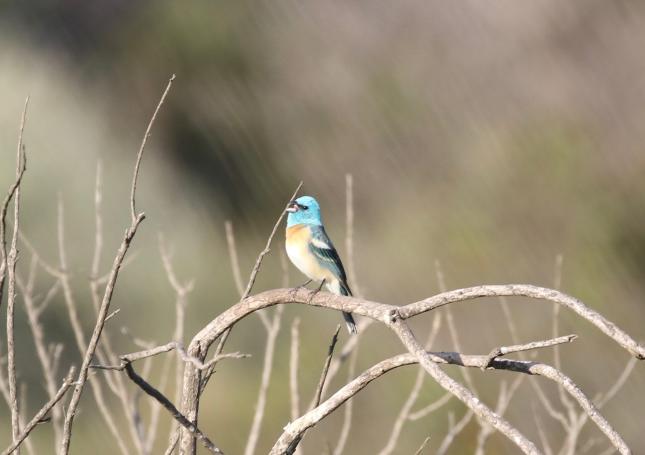Lazuli Bunting
 Adult breeding males are brilliant blue above with a pumpkin-colored breast and a white belly. Adult males also have a white shoulder patch that stands out on perched and flying birds. Females are warm grayish-brown above, with a blue tinge to the wings and tail, two buffy wingbars, and an unstreaked pale cinnamon or tan breast. Juveniles and nonbreeding males have a pumpkin-colored breast, but their backs and heads are mottled blue and tan.
Adult breeding males are brilliant blue above with a pumpkin-colored breast and a white belly. Adult males also have a white shoulder patch that stands out on perched and flying birds. Females are warm grayish-brown above, with a blue tinge to the wings and tail, two buffy wingbars, and an unstreaked pale cinnamon or tan breast. Juveniles and nonbreeding males have a pumpkin-colored breast, but their backs and heads are mottled blue and tan.- Lazuli Buntings breed in brushy hillsides, areas near streams, wooded valleys, thickets and hedges along agricultural fields, recently burned areas, and residential gardens of the West, up to about 9,500 feet elevation.
- Most species molt their feathers on either the breeding grounds or wintering grounds, but not the Lazuli Bunting. After breeding, they start molting some feathers but then migrate to the southwestern U.S. and northwestern Mexico, where insects are abundant following monsoon rains. They finish replacing their feathers in these “molting hotspots” before they head farther south for the winter.
- The oldest recorded Lazuli Bunting was a male, and at least 9 years, 1 month old when he was recaptured and rereleased during banding operations in Idaho in 1990. He had been banded in the same state in 1981.
- Lazuli Buntings arrive in the Conejo Valley in spring and spend the summer here. While you are more likely to see them if you take a hike out in the wild areas around the Conejo Valley, you may also see them in your yard.
Description provided from: All About Birds

